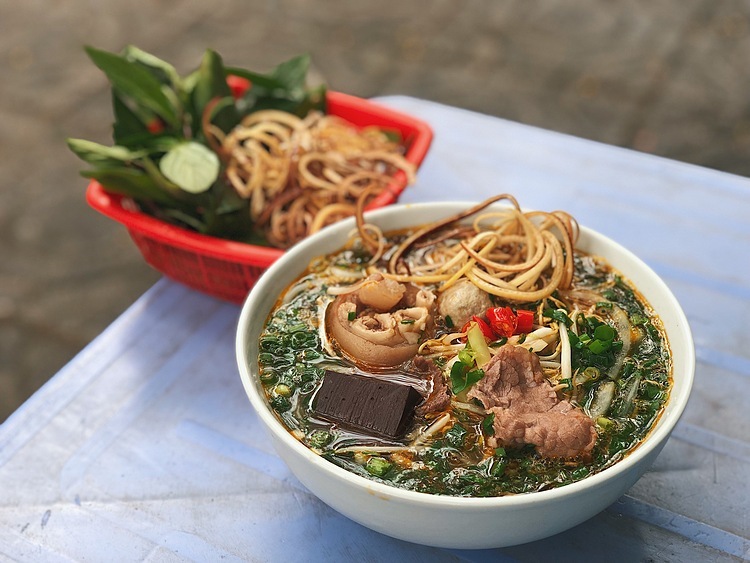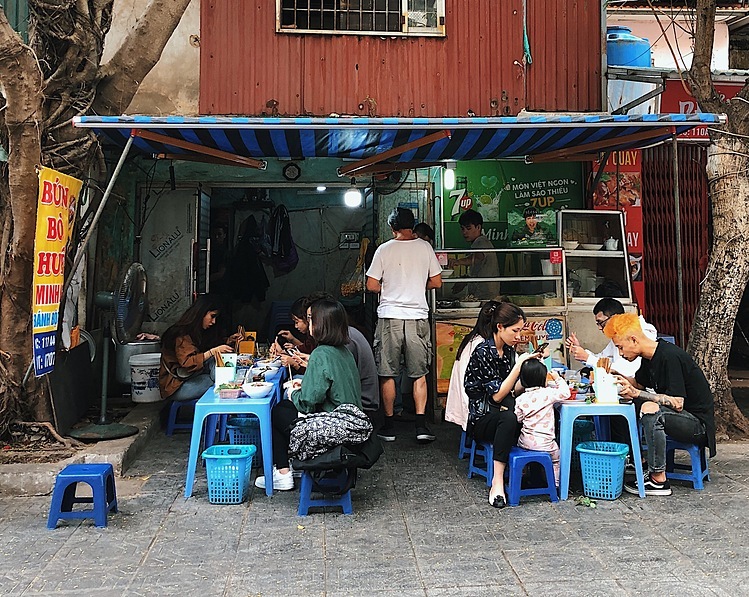If you visit the Thành Công food area for the first time, you'll see a row of eateries offering enticing dishes like bún, cháo, phở, mixed glass noodles, salad, tofu pudding, shrimp cakes, and bánh giò. However, there is only one bun bo Hue shop, where the fragrant aroma of lemongrass and fermented shrimp paste can be detected from afar.
Searching for the "Hue Flavor" in a Bowl of Bun Bo
In Hue, this dish is called "bun bo" or "bun bo gio heo," while in Hanoi and other places, it is usually referred to as "bun bo Hue" to indicate its origin. As a Hue native living far from home, I sometimes crave the taste of a traditional bowl of bun bo giò heo. Although my mother occasionally cooks it at home, I have yet to find the authentic "Hue flavor" like in the bowls made by the aunts and uncles in Hue.
A full bowl at Thanh Cong costs 35,000 VND and includes beef, beef balls, pork knuckle, pig’s blood pudding, and a rich, sweet broth with a characteristic reddish-orange hue. Diners can eat it with banana blossoms, bean sprouts, and herbs if they like. The round-cut pork knuckle is well-stewed, making it tender and slightly chewy.
The shop owner is from Hue. After getting married, she moved north with her husband. When they reached retirement age, their children suggested opening a bun shop to continue the family business, which has now been running for over ten years. Regular customers often call her "dì," which is equivalent to "cô" in the northern dialect.
"Customers enjoy the food and post about it online or recommend it to friends, but we don’t do any advertising. People have refined tastes—if they like a place, they will return, but if they don’t, they will only try it once. That’s why the quality of the bowl is the most important thing," said the shop owner.

Differences Between Bun Bo in Hue and Hanoi
The shop owner shared: "My parents used to sell bun in Hue, but now I'm the only one continuing the tradition. This job is very demanding; if you don’t have a passion for it, you won’t last. The key seasonings that create the Hue flavor, like fermented shrimp paste and seasoning powder, are all sourced from Hue. The pork and fresh vegetables are bought here—I wake up early every morning to personally select the freshest ingredients at the market."
For a Hue native like me, the bun bo here rates about 7/10 because the broth lacks the spiciness and the fragrant aroma of lemongrass and fermented shrimp paste. I once read that an authentic Hue-style broth should have: "A clear broth, the sweetness of simmered bones, the gentle aroma of lemongrass, and the distinct umami of shrimp paste."
Moreover, this shop doesn’t use the fragrant, sweet crab sausage commonly found in Hue, replacing it with beef balls instead. "I make bun bo Hue, but in a northern style to suit Hanoi’s palate. People here prefer beef, whereas crab sausage is not as popular," said the shop owner.
A regular customer shared: "I’ve tried bun bo in Hue, but I prefer it here. The bowls in Hue are a bit small and not as filling or flavorful as in Hanoi. Also, the spice level in Hue is too high for me."

The broth has been adjusted to suit northern tastes. This shop uses bones and beef tendons for sweetness, while in Hue, shrimp paste and pork knuckles are used. As a result, traditional Hue-style bun bo broth tends to be lighter in sweetness but saltier and spicier. A bowl in Hue is usually half the size of a typical bowl in Hanoi, and the accompanying ingredients like crab sausage and pig’s blood pudding are also smaller, including the noodles themselves.
There’s no definitive answer to the question: "Is bun bo Hue better in Hue or Hanoi?" since it depends on individual and regional preferences. However, if you have a chance to visit the ancient capital, be sure to stop by a street-side bun bo stall to enjoy the authentic "Hue flavor."
Why Choose NoodleSaigon20 Pho and Vermicelli?
At NoodleSaigon20, we believe that selecting the right rice is crucial to crafting authentic and delicious pho and vermicelli. We use carefully chosen rice varieties to produce high-quality noodles, ensuring an exceptional culinary experience for our customers.
01Traditional flavor, exceptional quality02International HACCP-certified factory
03Advanced freezing technology for preservation
04Convenient and easier to prepare compared to dried noodles
05Favored by international diners, exported to countries like Korea, Japan, etc.
|
Currently, the product is available for wholesale/retail in South Korea. You can place orders via Hotline, message on the Fanpage, or order directly on Coupang: |


